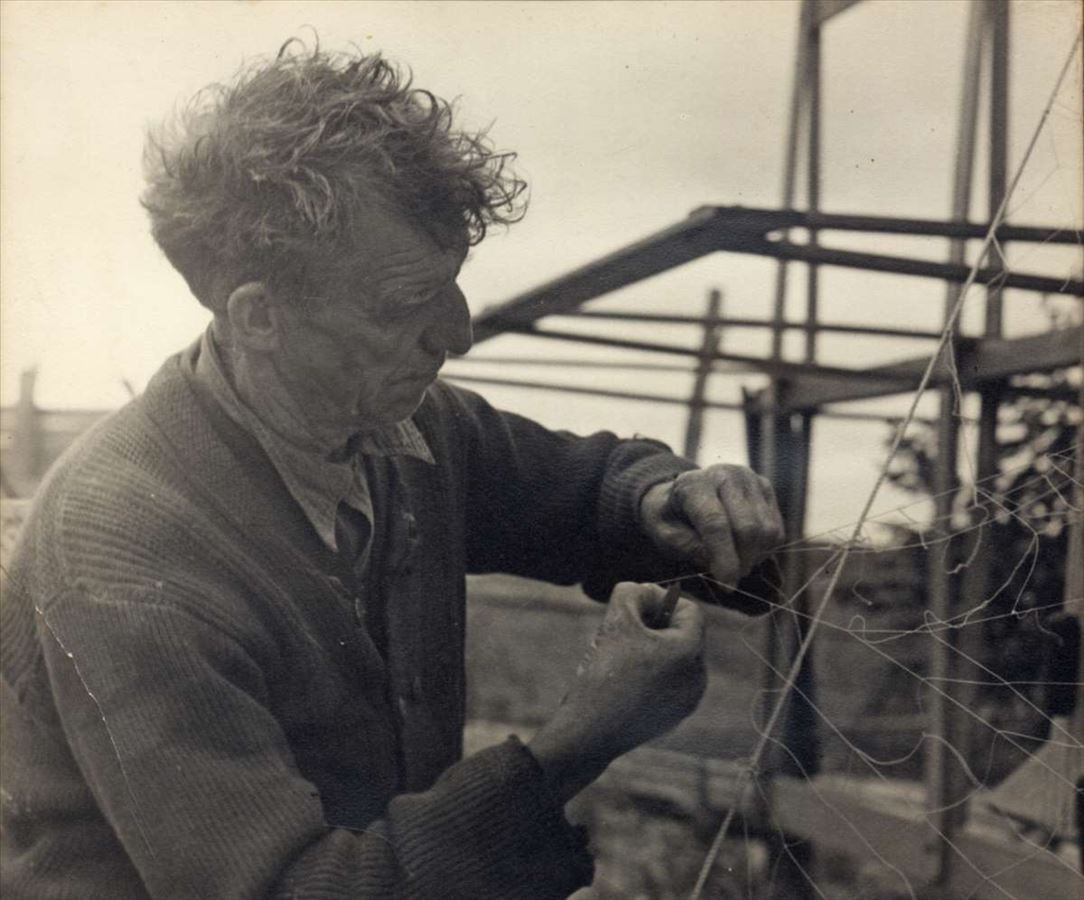By virtue of longevity and survival, the Carlsons are synonymous with Fishtown in Leland, Michigan. The Carlsons trace their local roots to the early 1900s, when Swedish immigrant Nels Carlson (1854-1935) moved his family from North Manitou Island to become the first Carlson to fish out of Leland. Well over a century later, a fifth generation of Carlsons are still part of Fishtown’s commercial fishing operations.
That long family history, however, almost ended prematurely with an unprecedented tragedy.
Nels’ eldest son Will followed in his footsteps as a fisherman, as did Will’s own son Lester, known as Pete. Will and Pete met as usual on the Fishtown docks on August 5, 1941, and set out together on the gill-netter Diamond for 16 Fathom Shoal, two hours away — one of the traditional fishing grounds farthest from port.
Diamond, like its fellow fishing tugs, had replaced the sails of the earliest generation of fishing boats with a gasoline engine, but like the earlier boats it had been built locally of wood. The fishermen needed no reminding about the dangers of running a gasoline engine (and in the cold weather a coal- or wood-fired stove for heat) on a wood boat. Will’s first tug, Leland, had burned and sunk off Fishtown in 1916, and when Wolverine burned to the railings, father and son Oscar and Vero Price had been forced into the water. Still, Fishtown had never lost a fisherman to fire or drowning.
But that August morning, Pete smelled gasoline. He checked the tank first, then the engine, and discovered the gasoline line had broken near the carburetor. Just as he reached to shut off the fuel, the engine backfired, igniting a fire in the boat. Reacting quickly, they sprayed the fire extinguisher on the flames, dousing the fire — until the extinguisher sputtered empty.
“We had one fire extinguisher,” Pete recalled, “[but] it doesn’t do any good to put water on gas. So there wasn’t anything we could do to put it out. We decided that we’d have to take to the water, my father and I, which we did, with two life preservers. The boat drifted away from us, and we started out for North [Manitou] Island” — eight miles away.
Fishtown fisherman Roy Buckler was also near 16 Fathom Shoal that day. “Pete and his dad caught fire there about fifteen minutes from where we were,” he said, “but we never saw anything. If we were going the other way, we would have seen it. We couldn’t figure out why Pete didn’t come [back]. We didn’t use radios until the 1950s. You just kept track of everybody.”
Battling exhausting and hypothermia, they tried to keep up their spirits by talking about the future and planning their new boat, but at midday, after eight hours in the water, Will fell silent. “My father died from exposure,” Pete said. “I kept him with me.”
Pete carried his father in his arms. After seven more hours, the South Manitou Coast Guard boat appeared. He tried to attract their attention. When he failed, he had to let his father go.
What Pete didn’t know was that there were more boats out on the water, looking for them. Pete’s wife, Rita, became concerned when the Diamond failed to return and called the Coast Guard station in
After his ordeal Pete Carlson didn’t know if he wanted to continue fishing. “He was sick for a long time over that,” Rita remembered. “He had carbuncles on his arms and hands. He was waking up at night, and he was always swimming. He thought he was going to make it to the island, but the current carried him out, because that’s what he did do. He had nightmares.”
It was a pivotal moment in Fishtown’s history. In spite of all the close calls on the lake, the fishermen had always soldiered on. Never before had one of their own drowned while fishing. At the tail end of the Depression, money for a new boat was tight. But when Pete learned that the community was raising money to buy him another boat, he mustered the will to make a trial run to see if he could handle being back on the lake. “He went out with Roy Buckler,” Rita remembered. “He went out a couple times, and he settled down, so he figured he could do it. And that’s how he went back to fishing with Gordon Carlson [his uncle], and Louis Steffens.” The new boat was built in Omena by John A. Johnson. “We called him Big John,” Rita recalled. “He was a big guy. And it was launched in Omena harbor there.” Rita chose the name Good Will to honor both Will Carlson and “the good will of the people that got it for us.”
In a community that has known its share of heartache and close calls, this particular story has become Fishtown’s formative narrative. It is the story of a son’s terrible choice and his incredible strength of spirit and body. “My dad holds the lake’s survival time record,” Pete’s son Bill Carlson once told the Detroit News, “and if it weren’t for his rugged constitution I wouldn’t be here today.” It is also the story of a community’s resolve to buy Pete Carlson a new boat and invest in Fishtown’s future. Of all the families of Fishtown, it is the Carlsons, who — through grit, luck, ingenuity, and a community’s generosity — continued Fishtown’s proud legacy of commercial fishing.
- Adapted from Laurie Kay Sommers, Fishtown:
Leland, Michigan's Historic Fishery (Fishtown Preservation, 2012)

